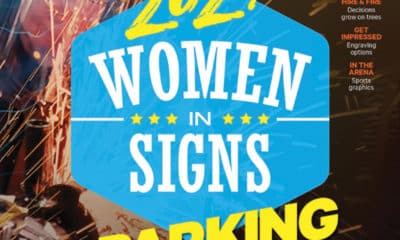Digital Printing
Technology Review: Mutoh’s ValueJet 1304 and RJ-900 Multi-functional Printers
Published
14 years agoon

If you own or operate a storefront signshop, a significant amount of your business probably comes from walk-in customers. And, if you have digital-print facilities in that storefront, surely someone has asked you to produce a large-format tradeshow sign, a poster or a blowup of a favorite photo.
Typically, if you accept – or want to accept – such work, your customer would leave the original artwork or photo, to give you time to scan, enlarge, enhance and print it. Your tools list would include a digital-print machine, large-format scanner, RIP or printer driver and, of course, a photo or art-editing software package. The delivery timeframe? An hour to a few days.
Mutoh’s new, ValueJet MFP (multi-function printer) series, with an incorporated, large-format scanner, printer and software, can do such a task in minutes.
About MFP
The MFP concept was introduced last spring, when Mutoh and GEI WideFormat (North Canton, OH) bundled GEI’s Colortrac SmartLF Gx+ 42 scanner with Mutoh’s 54-in.-wide, ValueJet 1304 printer, to create a multi-functional printer that would print outdoor-durable, wide-format prints. The companies arranged a similar bundle for Mutoh’s RJ-900 printer, which produces indoor prints on 42-in.-wide media. We have more information on both, below.
GEI Wide Format Solutions markets equipment, software and supplies through more than 100, North American dealer networks.
The Energy-Star compliant Gx+ 42 scanner is Colortrac’s sixth generation in this series. It’s designed as a graphics, not engineering, scanner and features six, digital-camera, digitizing units. It can handle media up to 42 x 48 in. and features instant start, a long-life LED-illumination system, 600- to 1,200-dpi, optical CCD resolution and fast speeds. Also, you can bump the image resolution to 9,600 dpi through the software’s interpolation.
The final 1304 MFP component is the computer system. At this writing, it’s a Dell Optiplex that includes at least a 2.53GHz core 2 Duo processor, 2GB of RAM, an 80GB SATA hard drive, and a 16X +/- RW DVD drive, Windows XP Professional OS and a 17-in., flat-panel monitor. The software bundle includes a scanning application for scanning to file or copying and the Flexi Print RIP package.
You can position the Colortrac scanner on a nearby tabletop or on a dedicated, adjacent stand.
Two MFP versions
Mutoh offers two MFP versions – the ValueJet 1304, a 54-in.-wide printer suitable for outdoor prints, and the J-900, for indoor prints on 42-in.-wide media. Mutoh’s ValueJet 1304 is a four-color, CMYK printer that’s easy to install, operate and maintain. The drop-on-demand, piezo-printhead machine features resolution settings of 540, 720 or 1440 dpi. It also offers 10 print modes and can print at speeds up to 145 sq. ft./hr. It comprises 1,440 total nozzles and variable-dot technology to apply Mutoh’s Eco-Ultra inks. The ink is available in 220-ml cartridges; it lasts up to three years outdoors, without lamination.
Images produced on the 1304 look great, even when selecting the higher-speed modes. The 1304 MFP will support media widths up to 54 in., with a 52.6-in. (bi-directional) maximum printing-image width or 53.35 in. (unidirectional). A media take-up system ships with the printer.
Both machines feature Mutoh’s patented Intelligent Interweaving (i²) print technology that applies ink dots in a wave pattern, to reduce banding. We described the process in an earlier review (see ST, November 2008, page 29), but want to repeat its virtues. The technique virtually eliminates banding and allows increased print speeds, thus creating high-grade print quality. Further, the system stabilizes dot-gain control, which allows more profile latitude.
If you don’t need outdoor images, a better choice may be the RJ-900 MFP. It’s designed for indoor graphics, photos and posters, plus engineering-type drawings. It’s a 42-in.-wide, engineering-grade, aqueous-ink (CMYK) printer that offers resolution ranges from 360 x 360 dpi to 1,440 x 2,880 dpi. It will produce both raster-based prints and popular vector-engineering formats, such as HPGL and HPGL2.
Depending upon your print-mode selection, the RJ-900 can be a real speed demon. For engineering line work printed in 360 x 360-dpi, single-pass mode, it will print at 460 sq. ft./hr. At a 720 x 720-dpi, four-pass mode, it will produce images at 84 sq. ft./hr.
The RJ-900 doesn’t have a take-up system and, instead, comes with a basket to catch images after printing. You may select dye or pigment-based inks. Typically, pigment inks are more durable, but the dye inks feature more vibrant colors.
The scanning unit also differentiates between the RJ-900 MFP and the 1304 MFP. The RJ-900 bundles the SmartLF Cx 40e scanner, which will accept media up to 40 x 44 in. It also accepts media thickness of 0.08 in., which limits it to paper media.
The Cx 40e scanning unit has an optical resolution of 600 dpi. Through interpolation, you can bump it to 3,600 dpi.
The RJ-900 incorporates the same computer system and monitor as the 1304. However, the software bundle isn’t as robust on the 1304. The 900 ships with user-interface software, to either copy a scan directly to the printer or scan to file, but doesn’t include the Flexi Print RIP package. Instead, it comes with a Windows driver for printing raster images or vector CAD files.
Is MFP right for you?
Is your shop highly visible? Do you see much walk-in business? If so, install the machine in front, where customers can see it print and, thereby, advance ideas for their own work.
Do you currently own and operate a digital printer? Either of Mutoh’s MFPs could get you started, but, obviously, the 1304 fits better into a signmaking operation. Its Flexi Print RIP will allow you to accept files for sign printing. You can also create your own designs.
Don’t forget that both printers will scan a large-format image and save it as a file – this can be another moneymaking service. Many people own desktop scanners, but typically, such devices are small format. By advertising, you may uncover a demand for large-image scanning, so don’t ignore that aspect.
Conclusion
The ValueJet 1304 MFP and RJ-900 MFP are two unique products. Although they’re not necessarily a “must have” in all signshops, in the right environment, they present a valid, business-expanding opportunity. They can also be a good bridge into the digital-print market.
Key Information
Mutoh America Inc.
2602 South 47th St., Ste. 102
Phoenix, AZ 85034
(480) 968-7772
www.mutoh.com
Company Profile: Mutoh Industries Ltd. was founded in 1952 in Tokyo. Originally, it manufactured and distributed mechanical-drafting products. Today, ISO 9000-certified Mutoh Industries Ltd. has become the one of the world’s principal manufacturers of large-format piezo-electric printers. In April, 2007, Mutoh Holdings Co. Ltd. was established as a holding company of affiliates, including Mutoh Industries Ltd. Mutoh has engineering, manufacturing and distribution centers in Japan, Belgium and Phoenix, AZ.
At a Glance: Mutoh united with GEI WideFormat to produce two, innovative, large-format, print/scan/copy machines. For outdoor graphics, Mutoh bundled GEI’s Colortrac SmartLF Gx+ 42 scanner with its 54-in.-wide, ValueJet 1304 printer, to create a multifunctional printer (MFP) for outdoor graphics. The package includes Flexi’s Print RIP package. In addition, Mutoh added GEI’s SmartLF Cx 40e scanner to its RJ-900 printer, which processes aqueous inks for indoor displays.
The CMYK RJ-900 is a 42-in.-wide printer with resolutions that range from 360 x 360 dpi to 1,440 x 2,880 dpi. It will produce both raster-based prints and popular, vector-engineering formats. Both machines feature Mutoh’s patented Intelligent Interweaving (i²) print technology that applies ink dots in a wave pattern, to reduce banding.
Contact: Crystal Baus, asst. marketing manager, (480) 968-7772 x 224; cbaus@mutoh.com
SPONSORED VIDEO
Introducing the Sign Industry Podcast
The Sign Industry Podcast is a platform for every sign person out there — from the old-timers who bent neon and hand-lettered boats to those venturing into new technologies — we want to get their stories out for everyone to hear. Come join us and listen to stories, learn tricks or techniques, and get insights of what’s to come. We are the world’s second oldest profession. The folks who started the world’s oldest profession needed a sign.
You may like
Advertisement
Subscribe

Magazine
Get the most important news
and business ideas from Signsofthetimes Magazine.
Advertisement
Most Popular
-

 Projects1 week ago
Projects1 week ago4 of the Most Fun Sign Projects in Years
-

 News1 week ago
News1 week ago2024 Sign Contest Open for Submission
-

 How To1 week ago
How To1 week agoMaking the Grade with ADA Signs
-

 Real Deal2 days ago
Real Deal2 days agoA Family Sign Company Foists Their Youngest Upon the Business
-

 Editor's Note3 days ago
Editor's Note3 days agoThe Joy of Working
-

 News2 days ago
News2 days agoWoman Found Living Inside Supermarket Sign
-

 News1 week ago
News1 week agoSign Company Owner Meets Travis Kelce
-

 Product Buying + Technology4 days ago
Product Buying + Technology4 days agoEco-Solvent Printers: Workhorses of a Signshop’s Stable










